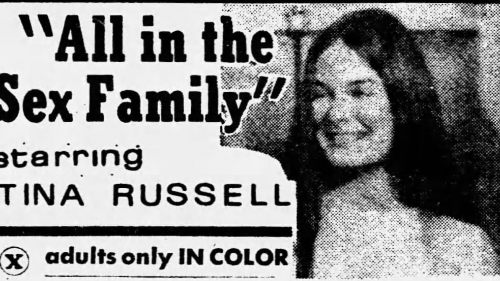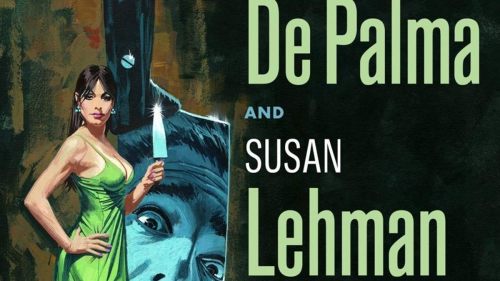Skin Flick: The Pornographic Majesty Of Brian De Palma’s BODY DOUBLE
Like most human beings, Brian De Palma enjoys pornography.
In the May/June 1987 issue of Film Comment, De Palma provided the publication with a catalogue of “Guilty Pleasures.” Amongst the apologetics was a 1981 slice of smut titled Nightdreams, directed by FX Pope. In reality, FX Pope doesn’t exist. The name was a nom de skin, belonging to commercial photographer and artist Francis Delia who, along with partner Stephen Sayadian, designed ads for everything from Hustler magazine to key art for major motion pictures. Included in their portfolio of immaculately designed one sheets (which also boasts John Carpenter’s The Fog and Escape From New York) was the iconic image for De Palma’s own Dressed to Kill. The admiration wasn’t one sided; in Nightdreams, Delia and Sayadian recreated the image from the piece of art they invented to help sell De Palma’s infamous murder mystery, repurposing it into one of the most harrowing scenes in the history of hardcore.
This critical shout-out could easily be construed as De Palma giving props to the two punk rock provocateurs for playing a part in his pseudo-autobiographical masterpiece. But De Palma helmed his own ode to the VHS era of '80s porn three years earlier with Body Double; a gaudy, sensationalist masterwork that is half comment on the very artifice of the motion picture, half middle finger to an establishment who condemned his ongoing fascination with sex and violence. Body Double is unapologetically lecherous, paying tribute to Roger Corman trash art like Slumber Party Massacre just as effortlessly as it does Alfred Hitchcock’s Vertigo. Seldom has a major Hollywood production been so brazen in its perverse braggadocio, as De Palma embraces every criticism lobbed at him during his already lengthy feature career and remolds them into razor sharp filmic weapons. Yet beyond being an expertly crafted piece of thriller pastiche, Body Double acts as a precursor to Paul Thomas Anderson’s Boogie Nights. Where Anderson delivered the definitive fictitious take on the skin flick factory of the '70s San Fernando Valley, De Palma was documenting his own decade’s neon-drenched adult film industry with an eye for MTV chic.
From the movie’s earliest moments, it’s readily apparent that Brian De Palma, as always, couldn't care less about anything remotely resembling reality. De Palma has always been a cineaste, first and foremost. His pictures revel in the form’s trickery, embracing technical formalism in a way that never lets the audience forget that they’re watching a motion picture. The first graveyard his camera hovers over in Body Double is quickly revealed to be nothing more than a movie set that doubles as an inescapable tomb for Jake Scully (Craig Wasson), the claustrophobic milquetoast thespian just trying to make a living in Hollywood as a “working actor.” The first sunset we see? Carried away, as it belongs to a matte painting being hauled by two nameless workers on a studio back lot. In previous thrillers like Sisters, Carrie and Obsession, De Palma was never subtle (just look at that barrage of split screens), but he was never overtly bull-horning his intentions like he is here. Just as Scully later finds himself playing dress up on a porn set where he doesn’t belong, the director is immersing the audience in his own crass recreation of a Hollywood he so despised by 1984*.
Even the plot of Body Double plays like a slick confluence of inspiration and cinematic ruse, as De Palma blocs his love for B-Movie horror with Hitchcockian sleight of hand. Much how Blow Out placed us in the shoes of a creator of disreputable art with John Travlota’s soundman sleuth, Body Double presents Scully as an emasculated waif (Wasson), recently cast in a schlocky vampire movie. Scully is a beige ne’er do well, catching his wife (future Stuart Gordon star Barbara Crampton in her first big screen role!) grinding on top of another man after he seized up on set due to his intense claustrophobia. Later, he’s fired by a De Palma clone (regular BDP player Dennis Franz), and lands a sublet in a lavish space needle, courtesy of a Seattle-bound colleague (the always welcome Gregg Henry). But the best part about the sky condo is the view, as its owner introduces the actor to a telescope that looks directly into the bedroom of a dancing, scantily clad beauty (the impossibly gorgeous Deborah Shelton). It’s Rear Window for an era that’s begun shooting porno on magnetic tape, as De Palma transforms Jimmy Stewart into an impotent creep, unable to do anything more than fantasize about the writhing vixen next door. Once he spots a rubber-faced Indian enjoying his own peep show from the roof of a nearby building, a white knight is born, chasing the lumbering, drill-wielding oaf as he tries to keep his spank bank mainstay safe. This being a Brian De Palma picture, nothing is as it seems. It’s only after the girl is penetrated with an overtly phallic drill (resulting in a “money shot” of gore that soaks through her apartment’s floor) that Scully has to put his dramatic skills to the test, draping himself in a red leather jacket as he enters the kinky world of adult entertainment, desperately seeking his faux lady love’s killer.
With Wasson, De Palma discovered the ultimate cypher. He’s an audience surrogate, so devoid of character, personality or agency that the entire movie seems to happen around him instead of the protagonist driving the picture. Even Roger Ebert, in his original glowing review of the movie, remarked, “He isn't smart, he isn't dumb, he isn't perfect, he isn't bad. He is an ideal choice to set up as a witness to a murder.” In other words, Wasson’s Scully just sort of exists, allowing us to project ourselves onto his Bill Maher-lite exterior in order to be transported into De Palma’s heightened universe. The choice to make Scully as vanilla pudding as possible is deliberate, and it’d feel like an insult to Wasson if the actor weren’t so knowingly game for the entirety of the movie’s near two-hour runtime. Yet there’s an almost impish glee Wasson conveys as he goes from helpless Peeping Tom to gullible murder suspect to undercover porn hustler in a mere matter of Acts. To criticize Scully for being a schmuck is missing the point entirely, for we are all dopey, doe-eyed adventurers in this cum-stained playground just looking for something to get off on.
But even if a viewer can’t get over Wasson’s jokingly willful naïveté, it’s hard to imagine anyone who truly loves cinema dismissing the virtuoso display of craftsmanship De Palma yet again employs in service of creating this sticky jungle. As Scully stalks, De Palma yet again unleashes his love of the Steadicam, transforming a California shrine to consumerism (The Rodeo Collection at 421 Rodeo Drive) into a veritable maze through which his camera can cruise. Later, De Palma stops the entire film dead in its tracks in order to stage an elaborately choreographed song and dance number set to Frankie Goes to Hollywood’s “Relax,” all of which ends in a round of softcore pawing. Had De Palma been allowed by the studio to execute his original concept (he wanted Body Double to be the first big budget picture to sport unsimulated sex scenes), it would’ve resulted in the most cinematically daring act of onscreen sex ever created. All the while, Pino Donaggio’s twinkling pianos, shimmering synths and soft drums add a playful sheen of eroticism, as the composer (and longtime BDP collaborator) seems most at home in this den of misdeeds.
None of this would matter if it weren’t for Holly Body (Melanie Griffith), the gyrating soul living in the movie’s black heart. De Palma initially cast Annette Haven, but Columbia Pictures made the director rethink the role once they discovered that she was an actual porn queen, having starred in numerous classic fuck films since 1973. But Columbia’s pearl-clutching became a blessing in disguise for the director, as Griffith ends up giving the greatest performance of her entire career. Holly Body is a marvel of a character, completely sexy while never once relinquishing control to her male counterparts. When propositioned to star in the fake movie Scully’s producing, she rattles off a litany of lewd acts that decimates the impotent actor’s confidence. The woman is a professional, direct and to the point, and no man is going to dictate what she does with her body just because he’s offering a paycheck. Griffith straddles the line between pixie dream girl and art rock ass-kicker with such command that it’s impossible to look away from her whenever she’s on screen. Casting a real life porn star in the role would’ve been a great gimmick, but we would’ve never been graced with such a scene-stealing performance. In the ultimate act of flattery, adult film actress Rochelle Trevis borrowed the stage name “Holly Body” and created a career around it, cementing Griffith’s character as an inspiration to the industry icons she’s aping.
Pornography is important, as it’s possibly the most confrontational art we have as a people. It challenges viewers not only to discover in themselves what they find to be arousing, but to embrace it as well. For centuries, human beings have been told through religion and the prudish laws of man that sex is a sinful act, to be enjoyed only in the most “traditional” fashion (i.e. wedlock). Keeping that in mind, it doesn’t feel like too big of a stretch to say that watching or creating porn suddenly becomes an act of defiance. Brian De Palma recognizes this inherent value. So while the studio stripped him of an opportunity to dabble in hardcore sex, he still ended up embracing the essence of the form’s artistic disobedience. Body Double is his petulant flip off to the critics**, who incessantly denounced the filmmaker as nothing more than a peddler of flesh and blood with a bit of a pretentious streak. Two hours of self-indulgence that is ultimately one of the most rewarding films of his career, brimming with a brash, aggressive attitude of a much younger man. All the while, De Palma never loses sight of who he truly is: an entertainer who never saw the need in differentiating between “high” and “low” art, thanks to spending just as much time in the Film Forum as he did on 42nd Street.
*Phantom of the Paradise, which was made a decade earlier, was partially inspired by the filmmaker’s frustrations with pitching original material to unimaginative studio executives.
**The title itself is an in-joke “fuck you” to those who gave Dressed to Kill flak when he utilized a younger stand-in for Angie Dickinson’s infamous shower scene.
Body Double screens at multiple Alamo Drafthouse locations this month. Check out showtimes here.



